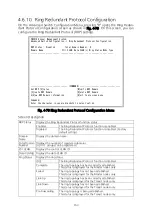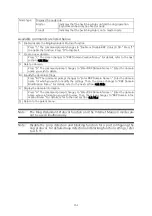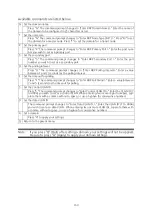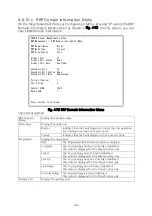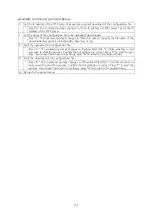
161
4.6.12. Digital Diagnostic Monitoring Menu
On the Advanced Switch Configuration Menu, pressing "G" opens the Digital Diag
-
nostic Monitoring Menu screen as shown in Fig. 4-76. On this screen, you can
change the information of Digital Diagnostic Monitoring.
PN28168 Local Management System
Advanced Switch Configuration -> Digital Diagnostic Monitoring Menu
Limit Trap Status : Disabled
SFP Port Number : 1 Transceiver Type : Unknown
Vendor Name : Vendor Product Number :
Vendor Serial Number :
RX Power TX Power Temp Voltage Bias Current
(dBm) (dBm) (deg. C) (V) (mA)
----------- ----------- ------------ --------- ------------
Status None None None None None
High Alarm 0.0000(A) 0.0000(A) 0.0000(A) 0.0000(A) 0.0000(A)
High Warning 0.0000(A) 0.0000(A) 0.0000(A) 0.0000(A) 0.0000(A)
Low Alarm 0.0000(A) 0.0000(A) 0.0000(A) 0.0000(A) 0.0000(A)
Low Warning 0.0000(A) 0.0000(A) 0.0000(A) 0.0000(A) 0.0000(A)
-------------------------------- <COMMAND> -----------------------------------
[N]ext SFP Port Set [R]x Power Limit Set T[e]mp Limit
[P]revious SFP Port Set [T]x Power Limit Set [B]ias Current Limit
Set Limit Trap [S]tatus Set [V]oltage Limit [Q]uit to previous menu
Command>
Enter the character in square brackets to select option
Fig. 4-76 Digital Diagnostic Monitoring Configuration
Screen Description
Limit Trap Status
Displays the trap sending settings for change state.
SFP Port Number
Displays the port to insert SFP modules.
Transceiver Type
Displays the type of SFP modules.
Vendor Name
Displays the vendor name of SFP modules.
Vendor Product Number
Displays the vendor product number of SFP modules.
Vendor Serial Number
Displays the vendor serial number of SFP modules.
Rx Power(dBm)
Displays the Rx power of SFP modules.
Tx Power(dBm)
Displays the Tx power of SFP modules.
Temp(deg.C)
Displays the temperature of SFP modules.
Voltage(V)
Displays the voltage of SFP modules.
Bias Current(mA)
Displays the bias current of SFP modules.
Status
Displays the state of SFP modules.
High Alarm
Displays the upper threshold of alarm.
High Warning
Displays the upper threshold of warning.
Low Alarm
Displays the lower threshold of alarm.
Low Warning
Displays the lower threshold of warning.




